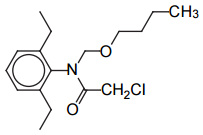Product Category
Contact us
Address: Room 2117, South Building, Yefeng Modern Center, Hangzhou, China
Contact: Mr.Huang 13805794603
Tel: 0086-571-87396576 / 86816681
Fax: 0086-571-87396570
E-mail: info@hzheruichem.com
Url: www.hzheruichem.com
Herbicide
Your Current Location: Home >> Herbicide
Butachlor
| Common name | Butachlor |
| Chemical name | 2-chloro-2',6'-diethyl-N-(butoxymethyl) acetanilide |
| CAS No. | 23184-66-9 |
| Molecular formula | C17H26NO2Cl |
| Molecular weight | 311.9 |
| Structure |  |
| Physical state | Clear amber liquid @ room temperature |
| Melting point | 4-5°C |
| Vapor pressure | 1.8*10-6mmHg @25°C |
| Decomposition temperature | 156°C |
| Water solubility | 20ppm @ 25°C |
| Solubility | Butachlor is miscible with alcohol, ether, acetone and other organic solvents. |
Applications:
Butachlor was administered in the diet to groups of 15 male and female Wistar Imamichi rats each, at concentrations of 0, 500, 1000, 2500, 5000, 10,000, 20,000 and 40,000ppm for 90 days. Reduced body weight gains were observed in males and females at the 5000ppm dietary level and above. Statistically significant decreases in feed consumption were found in male and female rats at 10,000ppm. There was mortality at the 10,000ppm dietary level or above but not at the 5000ppm or lower. At the dietary levels of 2500ppm and higher, hemoglobin concentration, hematocrit value and RBC were decreased, suggesting possible anemia. Decreased RBC CHE values in males at the 2500ppm dietary level and above, and females at 10,000ppm were noted. Plasma CHE was decreased in males at 10,000ppm but in females no decrease was found for plasma or brain CHE values. Statistically significant differences were found in brain, pituitary, ovary, uterus and heart weights, but there were no histopathological changes, and therefore, these organ weight changes were not considered biologically significant. Decreased kidney weights were observed in females at the 5000ppm dietary level and in males at the 10,000ppm dietary level. Spleen weight was reduced in both males and females at dietary levels of 2500ppm and higher. Histopathologically, dose-related changes were found in the spleen, kidney and liver of animals at dietary levels of 2500ppm and higher. Atrophy was observed in the ovaries and testes at 40,000ppm; these findings may have been related to malnutrition at this very high dose level. The NOEL for this study was considered to be 1000ppm (68.0mg/kg/day for males and 72.2mg/kg/day for females). (Nihon University of Veterinary Medicine and Zootechnology, 1971)


 Home
Home